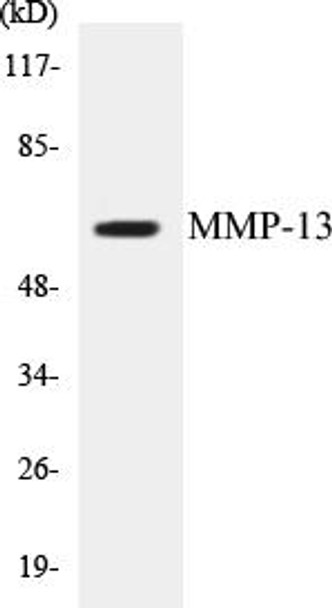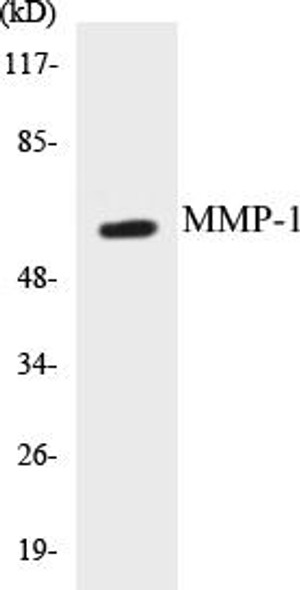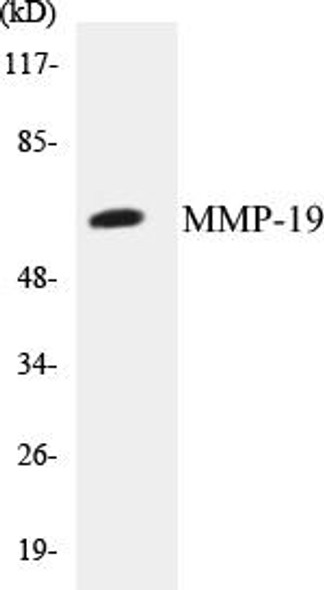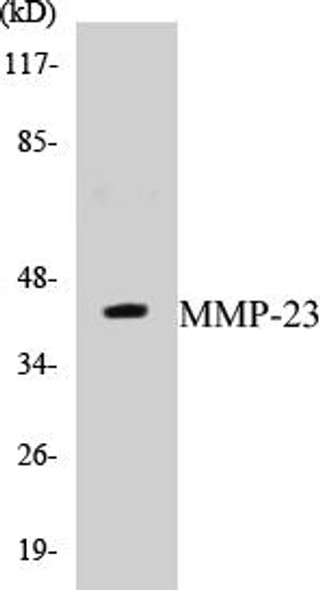Description
MMP-13 Colorimetric Cell-Based ELISA Kit
The MMP-13 Colorimetric Cell-Based ELISA Kit is a cutting-edge tool for the precise measurement of MMP-13 levels in cell culture samples. This kit boasts exceptional sensitivity and accuracy, guaranteeing consistent and trustworthy results for various research purposes.MMP-13, also known as collagenase-3, is a key enzyme involved in the degradation of extracellular matrix proteins, playing a critical role in tissue remodeling and wound healing processes. Dysregulation of MMP-13 has been implicated in various pathological conditions, including arthritis, cancer, and cardiovascular diseases, making it a valuable marker for understanding disease mechanisms and developing potential interventions.
With the MMP-13 Colorimetric Cell-Based ELISA Kit, researchers can confidently explore the role of MMP-13 in physiological and pathological processes, paving the way for groundbreaking discoveries and advancements in the field of molecular biology and medicine.
| Product Name: | MMP-13 Colorimetric Cell-Based ELISA |
| Product Code: | CBCAB00763 |
| ELISA Type: | Cell-Based |
| Target: | MMP-13 |
| Reactivity: | Human |
| Dynamic Range: | > 5000 Cells |
| Detection Method: | Colorimetric 450 nmStorage/Stability:4°C/6 Months |
| Format: | 96-Well Microplate |
The MMP-13 Colorimetric Cell-Based ELISA Kit is a convenient, lysate-free, high throughput and sensitive assay kit that can detect MMP-13 protein expression profile in cells. The kit can be used for measuring the relative amounts of MMP-13 in cultured cells as well as screening for the effects that various treatments, inhibitors (ie siRNA or chemicals), or activators have on MMP-13.
Qualitative determination of MMP-13 concentration is achieved by an indirect ELISA format. In essence, MMP-13 is captured by MMP-13-specific primary antibodies while the HRP-conjugated secondary antibodies bind the Fc region of the primary antibody. Through this binding, the HRP enzyme conjugated to the secondary antibody can catalyze a colorimetric reaction upon substrate addition. Due to the qualitative nature of the Cell-Based ELISA, multiple normalization methods are needed:
| 1. | A monoclonal antibody specific for human GAPDH is included to serve as an internal positive control in normalizing the target absorbance values. |
| 2. | Following the colorimetric measurement of HRP activity via substrate addition, the Crystal Violet whole-cell staining method may be used to determine cell density. After staining, the results can be analysed by normalizing the absorbance values to cell amounts, by which the plating difference can be adjusted. |
| Database Information: | Gene ID: 4322, UniProt ID: P45452, OMIM: 600108/602111, Unigene: Hs.2936 |
| Gene Symbol: | MMP13 |
| Sub Type: | None |
| UniProt Protein Function: | MMP13: Degrades collagen type I. Does not act on gelatin or casein. Could have a role in tumoral process. Defects in MMP13 are the cause of spondyloepimetaphyseal dysplasia Missouri type (SEMD-MO). A bone disease characterized by moderate to severe metaphyseal changes, mild epiphyseal involvement, rhizomelic shortening of the lower limbs with bowing of the femora and/or tibiae, coxa vara, genu varum and pear-shaped vertebrae in childhood. Epimetaphyseal changes improve with age. Defects in MMP13 are the cause of metaphyseal anadysplasia type 1 (MANDP1). Metaphyseal anadysplasia consists of an abnormal bone development characterized by severe skeletal changes that, in contrast with the progressive course of most other skeletal dysplasias, resolve spontaneously with age. Clinical characteristics are evident from the first months of life and include slight shortness of stature and a mild varus deformity of the legs. Patients attain a normal stature in adolescence and show improvement or complete resolution of varus deformity of the legs and rhizomelic micromelia. Belongs to the peptidase M10A family. |
| UniProt Protein Details: | Protein type:Secreted; EC 3.4.24.-; Secreted, signal peptide; Protease Chromosomal Location of Human Ortholog: 11q22.3 Cellular Component: extracellular region Molecular Function:calcium ion binding; collagen binding; metalloendopeptidase activity; serine-type endopeptidase activity; zinc ion binding Biological Process: collagen catabolic process; extracellular matrix disassembly Disease: Spondyloepimetaphyseal Dysplasia, Missouri Type |
| NCBI Summary: | This gene encodes a member of the peptidase M10 family of matrix metalloproteinases (MMPs). Proteins in this family are involved in the breakdown of extracellular matrix in normal physiological processes, such as embryonic development, reproduction, and tissue remodeling, as well as in disease processes, such as arthritis and metastasis. The encoded preproprotein is proteolytically processed to generate the mature protease. This protease cleaves type II collagen more efficiently than types I and III. It may be involved in articular cartilage turnover and cartilage pathophysiology associated with osteoarthritis. Mutations in this gene are associated with metaphyseal anadysplasia. This gene is part of a cluster of MMP genes on chromosome 11. [provided by RefSeq, Jan 2016] |
| UniProt Code: | P45452 |
| NCBI GenInfo Identifier: | 1168998 |
| NCBI Gene ID: | 4322 |
| NCBI Accession: | P45452.1 |
| UniProt Secondary Accession: | P45452,Q6NWN6, A8K846, B2RCZ3, |
| UniProt Related Accession: | P45452 |
| Molecular Weight: | 53,820 Da |
| NCBI Full Name: | Collagenase 3 |
| NCBI Synonym Full Names: | matrix metallopeptidase 13 |
| NCBI Official Symbol: | MMP13 |
| NCBI Official Synonym Symbols: | CLG3; MANDP1; MMP-13 |
| NCBI Protein Information: | collagenase 3 |
| UniProt Protein Name: | Collagenase 3 |
| UniProt Synonym Protein Names: | Matrix metalloproteinase-13; MMP-13 |
| Protein Family: | Collagenase |
| UniProt Gene Name: | MMP13 |
| UniProt Entry Name: | MMP13_HUMAN |
| Component | Quantity |
| 96-Well Cell Culture Clear-Bottom Microplate | 2 plates |
| 10X TBS | 24 mL |
| Quenching Buffer | 24 mL |
| Blocking Buffer | 50 mL |
| 15X Wash Buffer | 50 mL |
| Primary Antibody Diluent | 12 mL |
| 100x Anti-Phospho Target Antibody | 60 µL |
| 100x Anti-Target Antibody | 60 µL |
| Anti-GAPDH Antibody | 60 µL |
| HRP-Conjugated Anti-Rabbit IgG Antibody | 12 mL |
| HRP-Conjugated Anti-Mouse IgG Antibody | 12 mL |
| SDS Solution | 12 mL |
| Stop Solution | 24 mL |
| Ready-to-Use Substrate | 12 mL |
| Crystal Violet Solution | 12 mL |
| Adhesive Plate Seals | 2 seals |
The following materials and/or equipment are NOT provided in this kit but are necessary to successfully conduct the experiment:
- Microplate reader able to measure absorbance at 450 nm and/or 595 nm for Crystal Violet Cell Staining (Optional)
- Micropipettes with capability of measuring volumes ranging from 1 µL to 1 ml
- 37% formaldehyde (Sigma Cat# F-8775) or formaldehyde from other sources
- Squirt bottle, manifold dispenser, multichannel pipette reservoir or automated microplate washer
- Graph paper or computer software capable of generating or displaying logarithmic functions
- Absorbent papers or vacuum aspirator
- Test tubes or microfuge tubes capable of storing ≥1 ml
- Poly-L-Lysine (Sigma Cat# P4832 for suspension cells)
- Orbital shaker (optional)
- Deionized or sterile water
*Note: Protocols are specific to each batch/lot. For the correct instructions please follow the protocol included in your kit.
| Step | Procedure |
| 1. | Seed 200 µL of 20,000 adherent cells in culture medium in each well of a 96-well plate. The plates included in the kit are sterile and treated for cell culture. For suspension cells and loosely attached cells, coat the plates with 100 µL of 10 µg/ml Poly-L-Lysine (not included) to each well of a 96-well plate for 30 minutes at 37°C prior to adding cells. |
| 2. | Incubate the cells for overnight at 37°C, 5% CO2. |
| 3. | Treat the cells as desired. |
| 4. | Remove the cell culture medium and rinse with 200 µL of 1x TBS, twice. |
| 5. | Fix the cells by incubating with 100 µL of Fixing Solution for 20 minutes at room temperature. The 4% formaldehyde is used for adherent cells and 8% formaldehyde is used for suspension cells and loosely attached cells. |
| 6. | Remove the Fixing Solution and wash the plate 3 times with 200 µL 1x Wash Buffer for five minutes each time with gentle shaking on the orbital shaker. The plate can be stored at 4°C for a week. |
| 7. | Add 100 µL of Quenching Buffer and incubate for 20 minutes at room temperature. |
| 8. | Wash the plate 3 times with 1x Wash Buffer for 5 minutes each time. |
| 9. | Add 200 µL of Blocking Buffer and incubate for 1 hour at room temperature. |
| 10. | Wash 3 times with 200 µL of 1x Wash Buffer for 5 minutes each time. |
| 11. | Add 50 µL of 1x primary antibodies (Anti-MMP-13 Antibody and/or Anti-GAPDH Antibody) to the corresponding wells, cover with Parafilm and incubate for 16 hours (overnight) at 4°C. If the target expression is known to be high, incubate for 2 hours at room temperature. |
| 12. | Wash 3 times with 200 µL of 1x Wash Buffer for 5 minutes each time. |
| 13. | Add 50 µL of 1x secondary antibodies (HRP-Conjugated AntiRabbit IgG Antibody or HRP-Conjugated Anti-Mouse IgG Antibody) to corresponding wells and incubate for 1.5 hours at room temperature. |
| 14. | Wash 3 times with 200 µL of 1x Wash Buffer for 5 minutes each time. |
| 15. | Add 50 µL of Ready-to-Use Substrate to each well and incubate for 30 minutes at room temperature in the dark. |
| 16. | Add 50 µL of Stop Solution to each well and read OD at 450 nm immediately using the microplate reader. |
(Additional Crystal Violet staining may be performed if desired – details of this may be found in the kit technical manual.)






